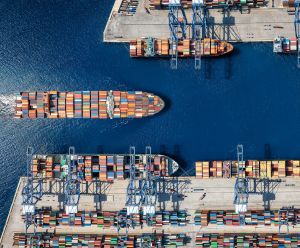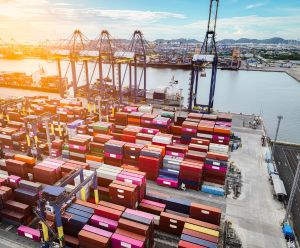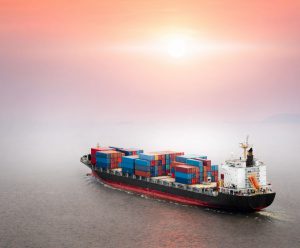
The reality of overcapacity is setting in

Where will all the new ships be deployed? That is the question many in the industry are asking as container lines take delivery of an avalanche of new vessels, even as many are sailing at less-than-optimal utilization levels and rates hit new lows.
Alphaliner deems the “colossal orderbook” hanging over the container market as “a sword of Damocles”. In late February, the analyst detailed how the world’s 11 largest container lines would receive 89 new mainline ships of between 13,000 TEU and 24,000 TEU capacity in 2023.
At the start of February, a total orderbook of 7.69m TEU represented around 30 percent of the active global box ship fleet.
Of the total orderbook, a huge 32 percent is due for delivery this year and 38 percent in 2024.
“This year will thus see the arrival of the box ship delivery ‘wave’ that follows the ordering frenzy of 2020 and 2021,” noted Alphaliner. “At least for the time being, it looks as if all this extra tonnage will hit the liner trades at a time of faltering demand.” The result would be a “a return of overcapacity” to container shipping.
In February, the Shanghai Containerized Freight Index (SCFI) dropped below 1,000 points for the first time since July 2022, and the gap between spot and contract markets is quickly narrowing. These factors fuel concerns that a price war might break out between carriers.
Capacity cuts amidst bottlenecks
Carriers are taking steps to stem rate declines by removing capacity, albeit some experts argue they have done too little, too late. The commercially inactive fleet on 13 February totaled 366 vessels. This was equivalent to 6.2 percent of the global cellular fleet, up from 5.7 percent two weeks earlier, noted Alphaliner.
Ship demolitions are also on the rise. MSI consultancy said scrapping would keep net fleet growth at modest levels for the feeder and midsize segments of the fleet. “Nevertheless,” MSI added, “it seems that overcapacity cannot be prevented in the large segment, as there are no demolitions anticipated there and an avalanche of new deliveries.”
Meanwhile, Peter Sand, chief analyst at Xeneta predicted that 25 percent of the scheduled orderbook will be postponed.
Carriers are also now blanking sailings, putting vessels into ‘hot’ and ‘cold’ layups and implementing fleet-wide slow steaming strategies. Reports also suggest that sending ships around the Cape of Good Hope instead of the Suez Canal will also be used to cut capacity on Asia-Europe services. This strategy that saves significant transit fees, but also drives up fuel consumption.
Most major port bottlenecks in Europe and the U.S. have now been cleared, but the March DHL Ocean Freight Market Update notes that the inland transport situation in Europe could be disrupted in various countries by strikes which impact productivity in the coming weeks.
Capacity constraints within the rail yards and chassis shortages still occur throughout the U.S. Also, seasonal weather delays are expected for truck and rail moves in North America and Canada.
Demand on track for growth
More positively, there are some signs that the macroeconomic landscape is improving. The March DHL Ocean Freight Market Update reports that the eurozone “may avert a recession” and the U.S. economy is entering 2023 “with a new burst of energy”.
Dominique von Orelli, Global Head, Ocean Freight, DHL Global Forwarding, said the market is normalizing, despite trade flows on many lanes being weaker than during the pandemic-driven import boom. “We are still facing macroeconomic headwinds including high inflation, interest rates and inventory levels, but this isn’t a market collapse,” he said. “This is trending towards stability, and we expect the overall demand situation to improve in the second half of the year.”
The recent DHL Ocean Freight Update also noted that countries including India, Vietnam, and the Philippines will achieve real GDP growth rates above 5 percent in 2023. It also outlines why Asia Pacific will lead all regions in growth as mainland China reopens. “China’s shift from zero Covid-19 to economic stimulus is a long-awaited move, triggering more consumer spending and thus driving more imports into the China market ” said Kelvin Leung, CEO, DHL Global Forwarding Asia Pacific. “The increased consumption will positively affect demand, and return a much-needed balance to the market.”
Positive sentiments for economic outlook
China’s manufacturing activity moved into expansionary territory in February after six months of contraction. The Caixin China General Manufacturing Purchasing Managers’ Index (PMI), which gives an independent snapshot of the country’s manufacturing sector, came in at 51.6 in February, up from 49.2 the previous month.
Bennett Parrish, Global Economist at J.P.Morgan, said: “The February manufacturing PMIs point to a welcome return to growth for global industry, amid supply chains improvements and China's reopening. A bounce in new orders reinforces the signal from the output PMIs and should help to sustain the recovery in the coming months."
Meanwhile, the J.P.Morgan Global Manufacturing PMI also improved in February, rising to 50 from 49.1 in January. Economists are now more optimistic than they were at the end of last year, with shipping analyst firm Drewry upgrading its forecast for world port handling in 2023.
“Given the change of direction in the GDP outlook and general sentiment, we are now anticipating an uplift of 1.2 percent, compared to 0.8 percent previously,” commented Simon Heaney, Senior Manager for Container Research at Drewry. “Our assumptions include a cooling down in inflation, a weaker U.S. dollar and some inventory replenishment.”
MORE FROM THIS COLLECTION














 English
English